Comparing multiple airplane boarding methods
Introduction
Contents
Problem definition
Based on the video about different boarding methods from GCP Gray, I would like to simulate and compare different airplane boarding methods found in the video and possible other sources. The simulation would offer results about how long it takes for passangers board the plane or how often are the passangers stuck in queue, idling.
Method
Model
Model contains multiple boarding methods. Front to back, back to front, steffen, perfect and random. Number of passengers and plane parameters like number of seats or distance between seats can be adjusted.
Front to back
This method is made as ineffective as possible. Passengers have their designated seat as close to the plane entry as possible. This minimizes number of steps each passenger has to take, but it maximuzes idle time, because when passenger is putting their luggage into luggage compartment, they are blocking rest of the passengers that are waiting to go past them. Because seats are assigned isle first and not window first, it also maximizes number of times passengers have to go over another sitting passenger.
Back to front
Back to front method is used by most airlines today. In this simulation, the method is much more strict and passengers are ordered in ideal order in the queue, minimizing number of passenger switching.
Steffen
Steffen Boarding Method was proposed in the year 2008 by Jason Steffen.[1] It is supposed to be perfect and most optimal way to board the plane.
Passengers board back to front, but each takes one seat in every other row on the one side of the plane. Next row of passengers takes the same seat but on the opposite side of the plane. Then they fill the empty seats, again one side after the other. Now all of the window most seats on both sides of the plane are filled, the process is repeated but with seats closer to the isle.
Perfect
Perfect method is like Steffen method, but it doesn't skip seats.
Random
As the name suggests, the seats are assigned randomly.
Variables
people-count
This variable sets how many people will board the plane. Has to be greater than 0. If too high, NetLogo will throw "outside of the boundaries" exception, which means a person was set outside the world area. Lowering the people-count variable or increasing the size of the world area helps fix the issue.
seats-count
This variable sets the number of seats on both sides of the plane isle. If set to 2, there will be 2 seats on the left and two seats on the right. Has to be greater than 0.
luggage-time
Number of ticks a person spends putting their luggage into a luggage compartment. Every person has to put their luggage to a luggage compartment when they reach their designated row. Has to be zero or greater.
person-switch-time
Number of ticks a person spends switching with already seated person if they have to go over that seated person to reach their designated seat. Has to be zero or greater.
people-spacing
Sets the initial distance between people in line waiting to board the plane. Has to be greate than zero.
seats-sapcing
Sets the spacing between seats. Has to be greate than zero.



